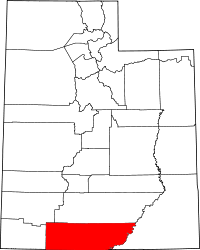Orderville, Utah
| Orderville | |
|---|---|
| Town | |
|
Orderville museum of the Daughters of Utah Pioneers | |
 Location in Kane County and the state of Utah | |
 Location of Utah in the United States | |
| Coordinates: 37°15′44″N 112°39′12″W / 37.26222°N 112.65333°WCoordinates: 37°15′44″N 112°39′12″W / 37.26222°N 112.65333°W | |
| Country | United States |
| State | Utah |
| County | Kane |
| Founded | 1875 |
| Incorporated | 1934 |
| Named for | United Order |
| Area | |
| • Total | 9.2 sq mi (23.8 km2) |
| • Land | 9.2 sq mi (23.8 km2) |
| Elevation | 5,449 ft (1,661 m) |
| Population (2012) | |
| • Total | 576 |
| • Density | 63/sq mi (24/km2) |
| Time zone | Mountain (MST) (UTC-7) |
| • Summer (DST) | MDT (UTC-6) |
| ZIP code | 84758 |
| Area code(s) | 435 |
| FIPS code | 49-57080[1] |
| GNIS feature ID | 1431023[2] |
Orderville is a town in Kane County, Utah, United States. The population was 596 at the 2000 census.
Geography
According to the United States Census Bureau, the town has a total area of 9.2 square miles (23.8 km²), all of it land.
Climate
This region experiences warm (but not hot) and dry summers, with no average monthly temperatures above 71.6 °F. According to the Köppen Climate Classification system, Orderville has a warm-summer Mediterranean climate, abbreviated "Csb" on climate maps.[3]
Demographics
| Historical population | |||
|---|---|---|---|
| Census | Pop. | %± | |
| 1880 | 514 | — | |
| 1890 | 289 | −43.8% | |
| 1900 | 418 | 44.6% | |
| 1910 | 380 | −9.1% | |
| 1920 | 378 | −0.5% | |
| 1930 | 439 | 16.1% | |
| 1940 | 441 | 0.5% | |
| 1950 | 371 | −15.9% | |
| 1960 | 398 | 7.3% | |
| 1970 | 399 | 0.3% | |
| 1980 | 423 | 6.0% | |
| 1990 | 422 | −0.2% | |
| 2000 | 596 | 41.2% | |
| 2010 | 577 | −3.2% | |
| Est. 2014 | 572 | [4] | −0.9% |
As of the census[1] of 2010, there were 577 people, 209 households, and 155 families residing in the town. The racial makeup of the town was 98.1% White, 0.2% Native American, 0.2% from other races, and .7% from two or more races. Hispanic or Latino of any race were 2.4% of the population.
There were 209 households out of which 25% had children under the age of 18 living with them, 65.1% were married couples living together, 7.7% had a female householder with no husband present, and 25.8% were non-families. 30.6% of all households were made up of individuals and 11.9% had someone living alone who was 65 years of age or older. The average household size was 2.76 and the average family size was 3.28.
In the town the population was spread out with 30.6% under the age of 18, 5% from 20 to 24, 16.8% from 25 to 44, 23% from 45 to 64, and 17.1% who were 65 years of age or older. The median age was 42.5 years. The total female population was 49.7% with 50.3% being male.
The median income for a household in the town was $44,297, and the median income for a family was $46,417. Males had a median income of $31,844 versus $21,000 for females. The per capita income for the town was $17,806. 12.4% of the population and 18.1% of families were below the poverty line. 17.8% of those under the age of 18 were below the poverty line as were 1.9% of those 66 or older.
History
Orderville was established at the direction of LDS Church president Brigham Young in 1875 specifically to live United Order, a voluntary form of communalism defined by Joseph Smith. Orderville was settled primarily by destitute refugees from failed settlements on the Muddy River in Nevada. The extreme poverty of these settlers likely contributed significantly to their devotion to the principles of the United Order.
Although the United Order was practiced in many Utah communities during the late 1870s, Orderville was unique in both the level of success it experienced under the communal living style, and in the duration of the experiment. In the course of a few years, Orderville grew into a thriving, self-sufficient community. The success and relative wealth of the community attracted more settlers and Orderville grew to about 700 people. Orderville not only provided for the needs of its population, but produced a significant surplus for sale to other communities, which was used to purchase additional land and equipment.
The Order continued in Orderville for approximately 10 years. During the early 1880s, The Church of Jesus Christ of Latter-day Saints lost interest in the experiment, but Orderville attempted to continue it. In 1885, the enforcement of the Edmunds Anti-Polygamy Act of 1882 effectively ended the Order by jailing many of the Order's leaders and driving many of the others underground.
References
- 1 2 "American FactFinder". United States Census Bureau. Retrieved 2008-01-31.
- ↑ "US Board on Geographic Names". United States Geological Survey. 2007-10-25. Retrieved 2008-01-31.
- ↑ Climate Summary for Orderville, Utah
- ↑ "Annual Estimates of the Resident Population for Incorporated Places: April 1, 2010 to July 1, 2014". Retrieved June 4, 2015.
- ↑ "Census of Population and Housing". Census.gov. Retrieved June 4, 2015.
External links
![]() Media related to Orderville, Utah at Wikimedia Commons
Media related to Orderville, Utah at Wikimedia Commons
| |||||||||||||||||||||||||

